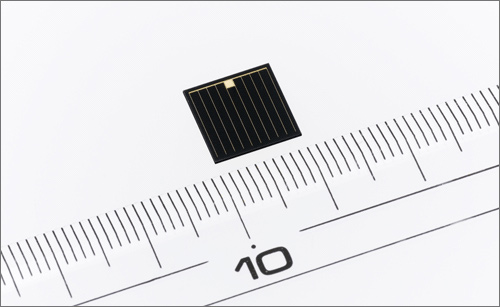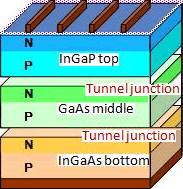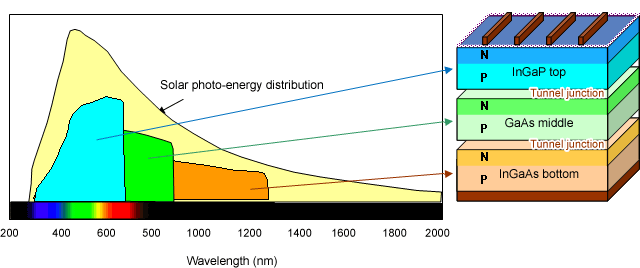
Triple-junction compound solar cell
with the world's highest conversion efficiency of 37.7%
Sharp Corporation has achieved the world's highest solar cell conversion efficiency*1 of 37.7%*2 using a triple-junction compound solar cell in which three photo-absorption layers are stacked together.
Sharp achieved this latest breakthrough as a result of a research and development initiative promoted by Japan's New Energy and Industrial Technology Development Organization (NEDO)*3 on the theme of "R&D on Innovative Solar Cells." Measurement of the value of 37.7%, which sets a new record for the world's highest conversion efficiency, was confirmed at the National Institute of Advanced Industrial Science and Technology (AIST).
Compound solar cells utilize photo-absorption layers made from compounds consisting of two or more elements, such as indium and gallium. The basic structure of this latest triple-junction compound solar cell uses proprietary Sharp technology that enables efficient stacking of the three photo-absorption layers, with InGaAs (indium gallium arsenide) as the bottom layer.
To achieve this latest increase in conversion efficiency, Sharp capitalized on the ability of the new cell to efficiently absorb light from different wavelengths in sunlight and convert it into electricity. Sharp also increased the active area*4 for converting light into electricity through optimal processing of the cell edges. These improvements led to higher maximum output levels for the solar cell and enabled Sharp to achieve a solar cell conversion efficiency of 37.7%—the highest in the world.
Sharp's aim for the future is to apply this latest development success to concentrator photovoltaic power systems that use lenses to collect and convert sunlight into electricity. The company also foresees numerous other practical applications for the cells, such as on space satellites and vehicles.
Structure of Triple-Junction Compound Solar Cell

- ・InGaP: Indium Gallium Phosphide
- ・GaAs: Gallium Arsenide
- ・InGaAs: Indium Gallium Arsenide
- ・Tunnel junction: Semiconductor junction where electricity flows as if through metal
- *1 As of December 5, 2012, for non-concentrator solar cells at the research level (based on a survey by Sharp).
- *2 Conversion efficiency confirmed by the National Institute of Advanced Industrial Science and Technology (AIST; one of several organizations around the world that officially certifies energy conversion efficiency measurements in solar cells) in September 2012. (Cell surface: approx. 1 cm2)
- *3 NEDO is one of Japan's largest public management organizations for promoting research and development as well as for disseminating industrial, energy, and environmental technologies.
- *4 The ratio of the effective light-reception area to the total surface area of the cell.
Wavelength Distribution of Solar Photo-Energy and Wavelength Sensitivity of Triple-Junction Compound Solar Cell

History of Sharp Compound Solar Cell Development
| 1967 |
Development begins of solar cells for space applications using single-crystal silicon |
| 1976 |
Launch of operational Japanese satellite, "Ume," equipped with Sharp solar cells for space applications (single-crystal silicon solar cell) |
| 2000 |
Research and development begin on triple-junction compound solar cells to further improve efficiency, reduce weight, and increase durability of solar cells for space applications |
| 2001 |
Participation in research and development on NEDO's photovoltaic power generation themes |
| 2002 |
Triple-junction compound solar cell gains certification from the Japan Aerospace Exploration Agency (JAXA) |
| 2003 |
Conversion efficiency of 31.5% achieved (at the research level) for a triple-junction compound solar cell |
| 2005 |
Launch of small scientific satellite, "Reimei," equipped with Sharp triple-junction compound solar cells |
| 2007 |
Conversion efficiency of 40.0% achieved (at the research level) for a triple-junction compound solar cell (concentrator type, at 1,100 times concentrated sunlight) |
 GOSAT Ibuki
(Photo: JAXA) |
| 2009 |
Launch of Greenhouse gases Observing SATellite (GOSAT), "Ibuki", equipped with Sharp triple-junction compound solar cells |
| 2009 |
Conversion efficiency of 35.8% achieved (at the research level) for a triple-junction compound solar cell*5 |
| 2011 |
Conversion efficiency of 36.9% achieved (at the research level) for a triple-junction compound solar cell*5 |
| 2012 |
Conversion efficiency of 43.5% achieved (at the research level) for a concentrator triple-junction compound solar cell*5 (concentrator type, at 360 times concentrated sunlight)
Conversion efficiency of 37.7% achieved (at the research level) for a triple-junction compound solar cell*5 |
 H-II Transfer Vehicle Kounotori3
(Photo: JAXA/NASA) |
- *5 Based on research and development efforts that are part of NEDO's "R&D on Innovative Solar Cells" project.